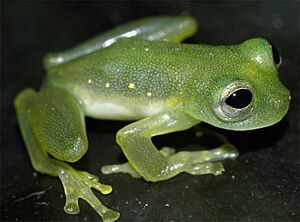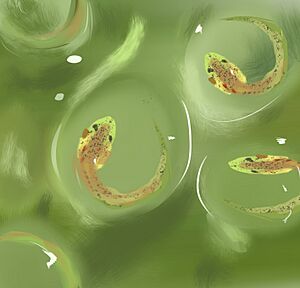Teratohyla midas facts for kids
Quick facts for kids Teratohyla midas |
|
|---|---|
 |
|
| Conservation status | |
| Scientific classification | |
| Synonyms | |
|
Centrolenella midas Lynch and Duellman, 1973 |
Teratohyla midas is a special type of frog known as the Santa Cecilia Cochran frog. It belongs to a group called Centrolenidae, which are also known as glass frogs. This frog was first officially described in 1973. It lives in the Amazon rainforest and looks a bit see-through, with cool gold spots on its back.
Many glass frogs, including T. midas, eat similar foods and live in similar places. However, they can look quite different in their body shapes and limbs. Because T. midas shares many features with other glass frogs, scientists often study them together.
Contents
Amazing Frog Features
T. midas frogs are mostly arboreal, which means they live in trees. Their skin is semi-transparent, so you can actually see their green bones! If it's a female frog, you might even spot her humerus spine, a bone in her arm.
These frogs have a unique snout shape that looks angled near their nostrils. Adult males are about 17.4 to 19.2 millimeters long, while females are a bit bigger, from 20.6 to 25.6 millimeters. Their finger pads are round and all about the same size. Their fingers don't have special skin fringes on the sides.
Both their hands and feet have some webbing. All their toes are fully webbed, but only their third and fourth fingers are completely webbed. The frogs are a dark lavender color, with bright yellow spots on their backs. These yellow spots are like human fingerprints; they are unique to each frog! Scientists use these spots to tell different frogs apart. When preserved, these yellow spots turn white. Their hands and feet are a dull greenish-yellow.
You can't see their heart, and their internal organs don't have color. Their eyes have a silvery-brown color with black patterns. T. midas is different from other glass frogs because of its unique internal organ setup. Their livers are covered by a clear membrane. When resting, these frogs keep all four legs tucked close to their bodies.
Why the Name "Midas"?
The common name "Santa Cecilia" comes from a place in Ecuador called Napo province. This area is where most of these frogs have been found over time.
The name "Midas" comes from an old Greek story about a king named Midas. King Midas could turn everything he touched into gold! So, the name Teratohyla midas refers to the golden specks you can see on the frog's back.
How They Camouflage
Glass frogs are famous for their see-through skin. In 2020, scientists did an experiment with T. midas and another glass frog, Espadarana prosoblepon, to understand how their skin helps them hide. They studied 25 adult T. midas frogs from French Guiana.
The scientists placed the frogs on a white background and then on a leaf background, like their natural home. They then observed how well the frogs blended in, using different ways of seeing, including how humans see.
Blending In with Surroundings
The results showed that the frog's semi-transparent body doesn't actually change its color to match its surroundings. Instead, it changes how bright or dim its body appears. This helps the frog blend into the environment by matching the light levels around it.
Also, the see-through body makes the frog's outline less clear when it's on a leaf. This blurring helps the frog disappear, making it harder for predators to spot. Scientists also think that being semi-transparent (not completely clear) might protect the frog's internal organs from harmful UV rays from the sun.
Where They Live
T. midas frogs are mostly found in the lowlands of South America. These areas have many different kinds of vegetation, including both wet and dry forests. You can usually find them at heights between 190 and 1050 meters above sea level. The most eastern place they've been found is in French Guiana.
Because T. midas is found over such a wide area, scientists think there might be different groups of these frogs that are very similar but slightly different.
Protecting Their Homes
The baby frogs, called tadpoles, grow in streams. Sadly, in some places, their homes are being destroyed. However, there are still large areas of good habitat left for them. While some glass frogs are kept as pets, there isn't much information about T. midas specifically being kept in homes.
Reproduction
Scientists haven't described the mating calls for most glass frog species. However, for T. midas, the male's mating call is a single short sound with three quick pulses. These calls can last from less than a second to over a minute.
Interestingly, the calls can change depending on where the frog lives. For example, frogs in Ecuador make calls with four pulses, while those in French Guiana and Brazil make calls with three pulses. The length of the pulses also varies by location.
There isn't a lot of information about how they reproduce, but scientists have seen females hopping from leaf to leaf with a male on their back, holding on tightly. One study in the Colombian Amazon suggested a pattern for where females lay their eggs. Females usually lay their eggs on rocks or plants that are above water. This way, when the eggs hatch into tadpoles, they can fall directly into the water below.
Parental Care
Where Eggs Are Laid
T. midas frogs often choose a plant called Selaginella to lay their eggs on. Scientists think this plant might help protect the eggs from common fungus infections because it has properties that fight bacteria and fungi. Also, these plants have rough, scaled leaves. The uneven edges of the leaves help the egg clutches stick better, preventing them from being blown away by wind or washed away by rain. There isn't a specific height at which T. midas always lays its eggs.
Protecting the Eggs
After the eggs are fertilized, the male frog usually leaves the egg-laying site. But the female stays behind to cover the eggs. Laying the eggs only takes a few seconds, but the female will keep the eggs under her belly for about an hour.
Scientists believe that this "egg-sitting" helps keep the eggs moist and protects them from predators or other dangers. This behavior is common among other glass frog species. An experiment showed that female attendance helps keep eggs moist in a species called Ikakogi tayrona, which is in the same family as T. midas.
Life Cycle and Growth
T. midas tadpoles are usually found in groups of eggs hanging over water. The tadpoles fully develop inside these clear, jelly-like eggs. Once they are ready, they drop into the water below.
When they are just developing embryos, the eggs look bright yellow inside a clear jelly clump and are shaped like beans. After they develop a tail bud and external gills, the tadpoles can still be seen inside the clear jelly of the eggs, with their tails curled up. These tiny tadpoles can even swim around inside their individual eggs!
You can see grey spots, especially around the tadpole's dorsal fin and head. Most of the tadpole's tissues are not see-through, but you can still see some internal parts like the midbrain, forebrain, and gut through their skin. At this stage, the gut looks bright green, while other internal structures appear dark red.
What They Eat and Who Eats Them
There isn't specific research on what Teratohyla midas eats, but most glass frogs hunt insects. Their diet includes things like crickets, moths, flies, and spiders.
As for predators, birds and other reptiles eat glass frogs. There have been reports of crested quetzal birds eating glass frogs in a place called Sierra de Perija. These birds catch the frogs in their beaks, and the glass frogs provide a good source of protein for these tropical birds.
Frog Family Tree
T. midas belongs to a group of frogs called Teratohyla. All the species in this group live in the lowland areas of South America. T. midas is most closely related to a species called Teratohyla adenocheira.
Scientists found that these two species became separate because of mountains. T. midas and T. adenocheira are separated by the Andes Mountains in South America. It's thought that they split apart about 2.7 million years ago, around the time when the Eastern Cordillera mountain range started to rise higher.



